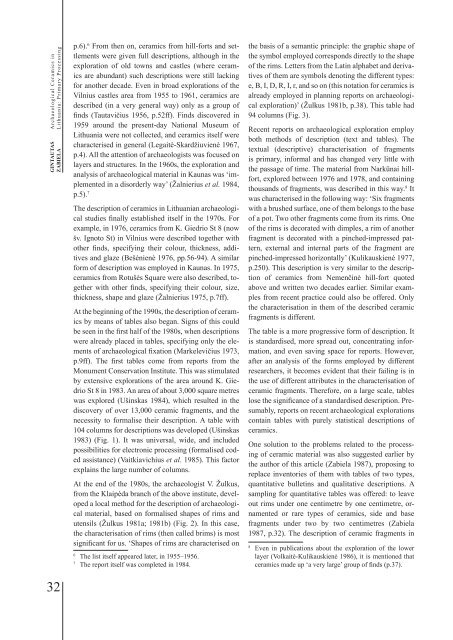BALTICA16 - Klaipėdos universitetas
BALTICA16 - Klaipėdos universitetas
BALTICA16 - Klaipėdos universitetas
You also want an ePaper? Increase the reach of your titles
YUMPU automatically turns print PDFs into web optimized ePapers that Google loves.
Archaeological Ceramics in<br />
Lithuania: Primary Processing<br />
GINTAUTAS<br />
ZABIELA<br />
32<br />
p.6). 6 From then on, ceramics from hill-forts and settlements<br />
were given full descriptions, although in the<br />
exploration of old towns and castles (where ceramics<br />
are abundant) such descriptions were still lacking<br />
for another decade. Even in broad explorations of the<br />
Vilnius castles area from 1955 to 1961, ceramics are<br />
described (in a very general way) only as a group of<br />
finds (Tautavičius 1956, p.52ff). Finds discovered in<br />
1959 around the present-day National Museum of<br />
Lithuania were not collected, and ceramics itself were<br />
characterised in general (Legaitė-Skardžiuvienė 1967,<br />
p.4). All the attention of archaeologists was focused on<br />
layers and structures. In the 1960s, the exploration and<br />
analysis of archaeological material in Kaunas was ‘implemented<br />
in a disorderly way’ (Žalnierius et al. 1984,<br />
p.5). 7<br />
The description of ceramics in Lithuanian archaeological<br />
studies finally established itself in the 1970s. For<br />
example, in 1976, ceramics from K. Giedrio St 8 (now<br />
šv. Ignoto St) in Vilnius were described together with<br />
other finds, specifying their colour, thickness, additives<br />
and glaze (Bešėnienė 1976, pp.56-94). A similar<br />
form of description was employed in Kaunas. In 1975,<br />
ceramics from Rotušės Square were also described, together<br />
with other finds, specifying their colour, size,<br />
thickness, shape and glaze (Žalnierius 1975, p.7ff).<br />
At the beginning of the 1990s, the description of ceramics<br />
by means of tables also began. Signs of this could<br />
be seen in the first half of the 1980s, when descriptions<br />
were already placed in tables, specifying only the elements<br />
of archaeological fixation (Markelevičius 1973,<br />
p.9ff). The first tables come from reports from the<br />
Monument Conservation Institute. This was stimulated<br />
by extensive explorations of the area around K. Giedrio<br />
St 8 in 1983. An area of about 3,000 square metres<br />
was explored (Ušinskas 1984), which resulted in the<br />
discovery of over 13,000 ceramic fragments, and the<br />
necessity to formalise their description. A table with<br />
104 columns for descriptions was developed (Ušinskas<br />
1983) (Fig. 1). It was universal, wide, and included<br />
possibilities for electronic processing (formalised coded<br />
assistance) (Vaitkiavichius et al. 1985). This factor<br />
explains the large number of columns.<br />
At the end of the 1980s, the archaeologist V. Žulkus,<br />
from the Klaipėda branch of the above institute, developed<br />
a local method for the description of archaeological<br />
material, based on formalised shapes of rims and<br />
utensils (Žulkus 1981a; 1981b) (Fig. 2). In this case,<br />
the characterisation of rims (then called brims) is most<br />
significant for us. ‘Shapes of rims are characterised on<br />
6 The list itself appeared later, in 1955–1956.<br />
7 The report itself was completed in 1984.<br />
the basis of a semantic principle: the graphic shape of<br />
the symbol employed corresponds directly to the shape<br />
of the rims. Letters from the Latin alphabet and derivatives<br />
of them are symbols denoting the different types:<br />
e, B, I, D, R, I, r, and so on (this notation for ceramics is<br />
already employed in planning reports on archaeological<br />
exploration)’ (Žulkus 1981b, p.38). This table had<br />
94 columns (Fig. 3).<br />
Recent reports on archaeological exploration employ<br />
both methods of description (text and tables). The<br />
textual (descriptive) characterisation of fragments<br />
is primary, informal and has changed very little with<br />
the passage of time. The material from Narkūnai hillfort,<br />
explored between 1976 and 1978, and containing<br />
thousands of fragments, was described in this way. 8 It<br />
was characterised in the following way: ‘Six fragments<br />
with a brushed surface, one of them belongs to the base<br />
of a pot. Two other fragments come from its rims. One<br />
of the rims is decorated with dimples, a rim of another<br />
fragment is decorated with a pinched-impressed pattern,<br />
external and internal parts of the fragment are<br />
pinched-impressed horizontally’ (Kulikauskienė 1977,<br />
p.250). This description is very similar to the description<br />
of ceramics from Nemenčinė hill-fort quoted<br />
above and written two decades earlier. Similar examples<br />
from recent practice could also be offered. Only<br />
the characterisation in them of the described ceramic<br />
fragments is different.<br />
The table is a more progressive form of description. It<br />
is standardised, more spread out, concentrating information,<br />
and even saving space for reports. However,<br />
after an analysis of the forms employed by different<br />
researchers, it becomes evident that their failing is in<br />
the use of different attributes in the characterisation of<br />
ceramic fragments. Therefore, on a large scale, tables<br />
lose the significance of a standardised description. Presumably,<br />
reports on recent archaeological explorations<br />
contain tables with purely statistical descriptions of<br />
ceramics.<br />
One solution to the problems related to the processing<br />
of ceramic material was also suggested earlier by<br />
the author of this article (Zabiela 1987), proposing to<br />
replace inventories of them with tables of two types,<br />
quantitative bulletins and qualitative descriptions. A<br />
sampling for quantitative tables was offered: to leave<br />
out rims under one centimetre by one centimetre, ornamented<br />
or rare types of ceramics, side and base<br />
fragments under two by two centimetres (Zabiela<br />
1987, p.32). The description of ceramic fragments in<br />
8 Even in publications about the exploration of the lower<br />
layer (Volkaitė-Kulikauskienė 1986), it is mentioned that<br />
ceramics made up ‘a very large’ group of finds (p.37).

















